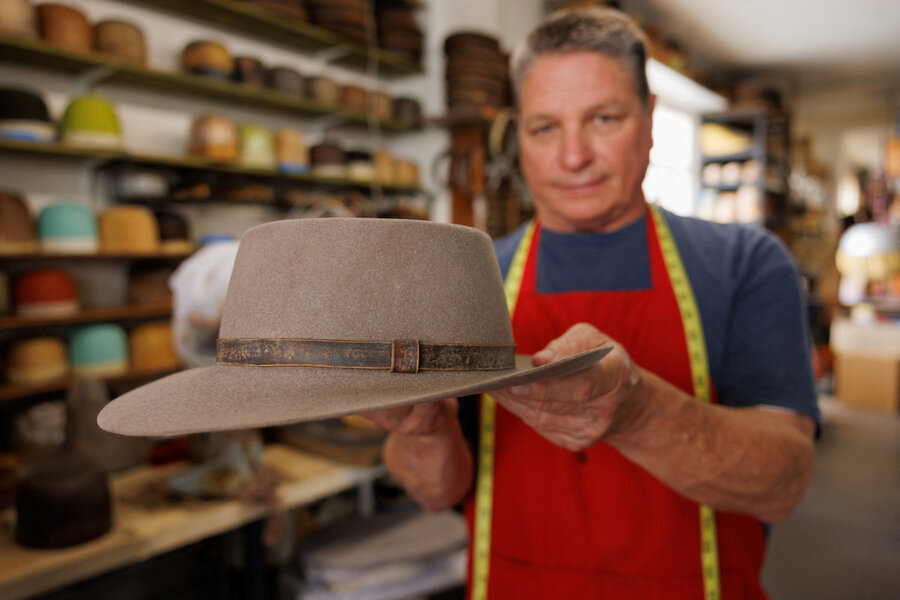Hat trick: How Oppenheimer’s iconic topper made it to the screen
Loading...
| Los Angeles
To create the look of renowned physicist J. Robert Oppenheimer for the big screen, his trademark hat had to be just right.
Two hatmakers had failed to replicate the scientist’s unique style when Mark Mejia, owner of Baron Hats, headed to a Hollywood studio lot to try his version on Cillian Murphy, the actor who would play the lead role in “Oppenheimer.”
Director Christopher Nolan joined the fitting and gave his approval, plus made a tweak of his own.
“He just cranked the brim down a little bit and gave it a little bit of attitude,” Mr. Mejia said.
The hat helped define the silhouette of Mr. Oppenheimer, the formidable scientist who led the 1940s race to build the first atomic bomb, in the movie that is the frontrunner to win best picture at the March 10 Academy Awards.
Mr. Mejia has three decades of experience making hats by hand for A-list movie stars from Clint Eastwood to Leonardo DiCaprio and musicians from Bob Dylan to Beyoncé.
His workshop sits on the third floor of a century-old building in downtown Los Angeles. On the first floor is B. Black & Sons, a family-owned woolen house that has supplied fabric for costumes since “Gone with the Wind.”
A hand-operated elevator shuttles visitors up to the Baron Hats showroom and workshop. Doors open into what looks like a museum of memorable Hollywood moments.
Among dozens of hats on display is a cowboy hat from Mr. Eastwood’s “Cry Macho.” Across the room is a straw boater donned by Johnny Depp as gangster John Dillinger in “Public Enemies.” A reproduction of Jim Carrey’s yellow, feather-adorned fedora from “The Mask” sits on a green-faced bust.
“It’s a long list,” Mr. Mejia says when asked to name the projects he has worked on, which include thousands of hats over the years.
He mentions the Russell Crowe drama “3:10 to Yuma,” TV series “Justified,” and Quentin Tarantino’s “Django Unchained,” plus work for bands such as AC/DC and Cheap Trick.
On the wall, a framed Rolling Stone magazine cover features folk singer Mr. Dylan wearing a silver hat made by Mr. Mejia, with a handwritten note of thanks from the singer. A photo shows Beyoncé sporting a black hat with a giant brim for her Formation tour. Mr. Mejia also is working on current projects with Beyoncé.
Rows of shelves feature reproductions of famous movie hats, such as the fedoras sported by Dick Tracy and Indiana Jones, that Baron sells to the public. Baron uses the original wood blocks used on the productions to recreate the shapes.
From sketches to the screen
A California native, Mr. Mejia started learning his craft after working as a science technician for the Los Angeles school district. He felt he had little job security and searched for another career, joining a friend who was a hatmaker in New York.
In 1993, Mr. Mejia apprenticed with Baron Hats founder Eddie Baron, who had started working for movie stars including John Wayne in 1969 and become Hollywood’s go-to hatter. Mr. Baron sold the business to Mr. Mejia in 1995.
To create a hat for a film, Mr. Mejia typically works from sketches supplied by costume designers and must figure out how to bring their ideas into three dimensions.
He often works with beaver or rabbit felt. Once a rough shape has been created, the felt is heated and steamed so that Mr. Mejia can stretch and shape it into the precise form.
“To really capture the silhouette of the costume, and the movie itself, it takes a lot of manipulating of the felt to really create the exact, iconic style that you want,” he said.
The Oppenheimer hat was an unusual shape. Costume designer Ellen Mirojnick describes it as a porkpie crown combined with something between a fedora and a cowboy brim.
Ms. Mirojnick, who is nominated for best costume design at the March 10 Oscars, studied black-and-white images and had to guess the hat’s color, deciding on a taupey gray. Designs were sent to hatmakers in Italy and New York, but neither could nail it.
Much closer to Hollywood, she found Mr. Mejia, who she said “hit it out of the park immediately.”
Getting it right was important, Ms. Mirojnick said, because the real-life Mr. Oppenheimer had intentionally crafted his look.
The hat, she said, was “part of the image that Oppenheimer created as he stepped into his power and opened up Los Alamos,” the New Mexico lab where the bomb was created. “He wore it all the time.”
Mr. Murphy wears one hat in the movie, reflecting the fact that Mr. Oppenheimer kept the same look throughout his life. At Mr. Nolan’s direction, most other characters in the film do not wear hats.
Mr. Mejia said he never sought a career working with celebrities, but he enjoys seeing his hats on film.
“There’s a lot of gratification and satisfaction,” he said, “when you actually build something with your hands from scratch and see it on the big screen.”
This story was reported by Reuters.







